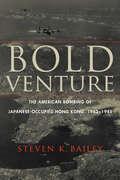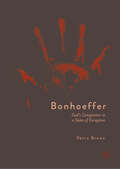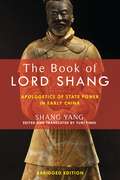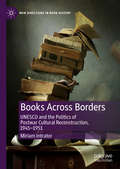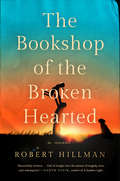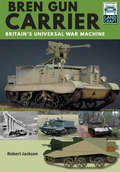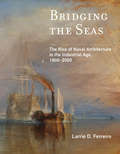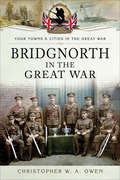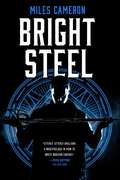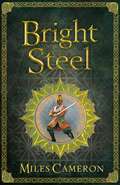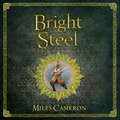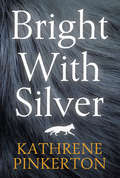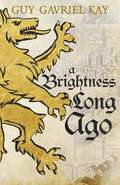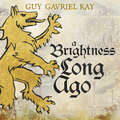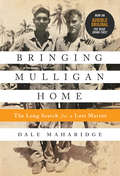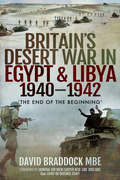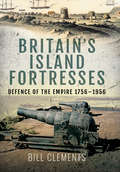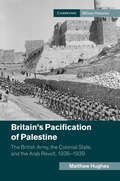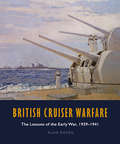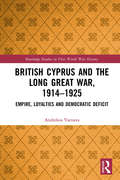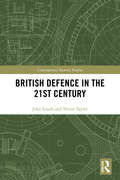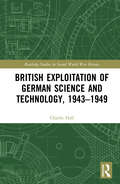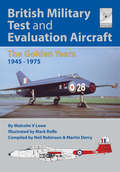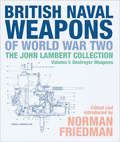- Table View
- List View
Bold Venture: The American Bombing of Japanese-Occupied Hong Kong, 1942–1945
by Steven K. BaileyBold Venture tells the nearly forgotten story of the American airmen who flew perilous combat missions over Hong Kong during the Second World War. Steven K. Bailey sheds new light on the American military campaign against Japanese forces in occupied China. From the first reconnaissance flights over Hong Kong by lone pilots in 1942 to the massive multi-squadron air strikes of 1945, he describes the complex history of American air operations in the China theater and paints an indelible portrait of the American air raids on Hong Kong and the airmen who were shot down over the city. Today unexploded aircraft bombs are unearthed with frightening regularity by construction crews in Hong Kong. Residents are eager to know where these bombs originated, who dropped them, when, and what the targets were. Bailey’s account answers some of these questions and provides a unique historical perspective for Americans seeking to understand the complexities of military involvement.
Bonhoeffer: God’s Conspirator in a State of Exception
by Petra BrownTheologian. Conspirator. Martyr. Saint. Dietrich Bonhoeffer was killed in the waning days of World War II, having been implicated in the July 20th assassination attempt on Hitler. Since his death, Bonhoeffer’s life and writings have inspired contradictory responses. He is often seen as a model for Christian pacifist resistance, and more recently for violent direct political action. Bonhoeffer’s name has been invoked by violent anti-abortion protestors as well as political leaders calling for support on a ‘war on terror’ in the aftermath of 9/11. Petra Brown critically analyses Bonhoeffer’s writing preceding and during his conspiracy involvement, particularly his recurring concept of the ‘extraordinary.’ Brown examines this idea in light of ‘the state of exception,’ a concept coined by the one-time Nazi jurist and political theorist, Carl Schmitt. She also draws on the existentialist philosopher Sören Kierkegaard to consider what happens when discipleship is understood as obedience to a divine command. This book aims to complicate an unreflective admiration of Bonhoeffer’s decision for conspiracy, and draws attention to the potentially dangerous implications of his emerging political theology.
The Book of Lord Shang: Apologetics of State Power in Early China (Translations from the Asian Classics)
by Yang ShangCompiled in China in the fourth–third centuries BCE, The Book of Lord Shang argues for a new powerful government to rule over society and turn every man into a diligent tiller and valiant soldier. Creating a “rich state and a strong army” will be the first step toward unification of “All-under-Heaven.” These ideas served the state of Qin that eventually created the first imperial polity on Chinese soil. In Yuri Pines’s translation, The Book of Lord Shang’s intellectual boldness and surprisingly modern-looking ideas shine through, underscoring the text’s vibrant contribution to global political thought.The Book of Lord Shang is attributed to the statesman and theorist Shang Yang and his followers. It epitomizes the ideology of China’s so-called Legalist School of thought. In the ninety years since the work’s previous translation, major breakthroughs in studies of the book’s dating and context have recast our understanding of its messages. Pines applies these advances to a whole new reading of the text’s content and function in the sociopolitical life of its times and subsequent centuries. This abridged and revised edition of Pines’s annotated translation is ideal for newcomers to the book while also guiding early Chinese scholars and comparatists. It highlights the text’s practical success and its influence on political thought and political practice in traditional and modern China.
Books Across Borders: UNESCO and the Politics of Postwar Cultural Reconstruction, 1945–1951 (New Directions in Book History)
by Miriam IntratorBooks Across Borders: UNESCO and the Politics of Postwar Cultural Reconstruction, 1945-1951 is a history of the emotional, ideological, informational, and technical power and meaning of books and libraries in the aftermath of World War II, examined through the cultural reconstruction activities undertaken by the Libraries Section of the United Nations Educational, Scientific and Cultural Organization (UNESCO). The book focuses on the key actors and on-the-ground work of the Libraries Section in four central areas: empowering libraries around the world to acquire the books they wanted and needed; facilitating expanded global production of quality translations and affordable books; participating in debates over the contested fate of confiscated books and displaced libraries; and formulating notions of cultural rights as human rights. Through examples from France, Poland, and surviving Jewish Europe, this book provides new insight into the complexities and specificities of UNESCO’s role in the realm of books, libraries, and networks of information exchange during the early postwar, post-Holocaust, Cold War years.
The Bookshop of the Broken Hearted
by Robert HillmanIn this tender and wise novel about love and forgiveness in 1960s Australia, a lonely farmer finds his life turned upside down by the arrival of a vibrant bookseller."Beautifully written. . . . Full of insight into the nature of tragedy, love, and redemption." --Garth Stein"Hillman guides us on a poignant journey of unthinkable loss, love, and the healing capacity of the written word." --Ellen Keith, author of The Dutch WifeCan one unlikely bookshop heal two broken souls?It is 1968 in rural Australia and lonely Tom Hope can't make heads or tails of Hannah Babel. Newly arrived from Hungary, Hannah is unlike anyone he's ever met--she's passionate, brilliant, and fiercely determined to open sleepy Hometown's first bookshop. Despite the fact that Tom has only read only one book in his life, when Hannah hires him to install shelving for the shop, the two discover an astonishing spark. Recently abandoned by an unfaithful wife--and still missing her sweet son, Peter--Tom dares to believe that he might make Hannah happy. But Hannah is a haunted woman. Twenty-four years earlier, she had been marched to the gates of Auschwitz.Perfect for fans of The Little Paris Bookshop and The Light Between Oceans, The Bookshop of the Broken Hearted cherishes the power of love, literature, and forgiveness to transform our lives, and--if we dare allow them--to mend our broken hearts.
Bren Gun Carrier: Britain's Universal War Machine (LandCraft #3)
by Robert JacksonA guide that blends the history behind this British tank with resources for military vehicle modeling enthusiasts. One of the most versatile fighting vehicles in the British army and many other forces for a quarter of a century, the Universal Carrier—more popularly known by its original title of Bren Gun Carrier—was developed as a fast and agile infantry-support vehicle. In this volume of Pen & Sword&’s LandCraft series, Robert Jackson traces its design and manufacturing history and describes its operational role throughout its long career. The Bren Carrier served in every theater of the Second World War, from northwest Europe, North Africa and the Soviet Union to the Far East. Then, with the war over, it was operated by many belligerents in a string of other conflicts around the world, including Israel&’s struggle for independence and the war in Korea. A selection of archive photographs showing the Bren Carrier in action gives a graphic impression of how adaptable it was and records the variety of equipment it could carry. The book is an excellent source for the modeler, providing details of available kits together with specially commissioned color profiles which illustrate how the Bren Carriers used by different units and armies appeared.
Bridging the Seas: The Rise of Naval Architecture in the Industrial Age, 1800-2000 (Transformations: Studies in the History of Science and Technology)
by Larrie D. FerreiroHow the introduction of steam, iron, and steel required new rules and new ways of thinking for the design and building of ships.In the 1800s, shipbuilding moved from sail and wood to steam, iron, and steel. The competitive pressure to achieve more predictable ocean transportation drove the industrialization of shipbuilding, as shipowners demanded ships that enabled tighter scheduling, improved performance, and safe delivery of cargoes. In Bridging the Seas, naval historian Larrie Ferreiro describes this transformation of shipbuilding, portraying the rise of a professionalized naval architecture as an integral part of the Industrial Age. Picking up where his earlier book, Ships and Science, left off, Ferreiro explains that the introduction of steam, iron, and steel required new rules and new ways of thinking for designing and building ships. The characteristics of performance had to be first measured, then theorized. Ship theory led to the development of quantifiable standards that would ensure the safety and quality required by industry and governments, and this in turn led to the professionalization of naval architecture as an engineering discipline. Ferreiro describes, among other things, the technologies that allowed greater predictability in ship performance; theoretical developments in naval architecture regarding motion, speed and power, propellers, maneuvering, and structural design; the integration of theory into ship design and construction; and the emergence of a laboratory infrastructure for research.
Bridgnorth in the Great War (Your Towns & Cities in the Great War)
by Christopher W. OwenThis social history of WWI explores the wartime sacrifices and contributions made by the people of this charming, historic English town. The town of Bridgnorth, located along the Severn River in Shropshire, is a popular tourist destination known for its historic castle and unique funicular rail system. Though it is steeped in military history, much of its role during the Great War has remained obscure until now. Misled by government propaganda, many of Bridgnorth&’s men enlisted in the military for what they thought would be a short-term adventure. Their commitment and fortitude in the face of bloody trench warfare gives testament to the incredible bravery of the people of Bridgnorth, and their losses are evidenced in the various commemorative monuments erected throughout the town and surrounding hamlets. Utilizing contemporary documents and wartime servicemen's poignant letters, some of which are disclosed here for the first time, Bridgnorth in the Great War reveals how this once prosperous and industrious West Midlands' town endured great sacrifice in the name of Britain&’s war effort.
Bridgnorth in the Great War (Your Towns & Cities in the Great War)
by Christopher W. OwenThis social history of WWI explores the wartime sacrifices and contributions made by the people of this charming, historic English town. The town of Bridgnorth, located along the Severn River in Shropshire, is a popular tourist destination known for its historic castle and unique funicular rail system. Though it is steeped in military history, much of its role during the Great War has remained obscure until now. Misled by government propaganda, many of Bridgnorth&’s men enlisted in the military for what they thought would be a short-term adventure. Their commitment and fortitude in the face of bloody trench warfare gives testament to the incredible bravery of the people of Bridgnorth, and their losses are evidenced in the various commemorative monuments erected throughout the town and surrounding hamlets. Utilizing contemporary documents and wartime servicemen's poignant letters, some of which are disclosed here for the first time, Bridgnorth in the Great War reveals how this once prosperous and industrious West Midlands' town endured great sacrifice in the name of Britain&’s war effort.
Bright Steel (Masters & Mages #3)
by Miles CameronA young mage-in-training is unwittingly pulled into a violent political upheaval, in the third book of this epic fantasy trilogy by Miles Cameron, author of the Traitor Son Cycle.Masters & MagesCold IronDark ForgeBright SteelFor more from Miles Cameron, check out:The Traitor Son CycleThe Red KnightThe Fell SwordThe Dread WyrmThe Plague of SwordsThe Fall of Dragons
Bright Steel: Masters and Mages Book Three (Masters & Mages)
by Miles CameronEvery war come down to the flash of bright steel.Even when the air is full of magic . . .Aranthur and his friends have come together across different continents and realms with one purpose: to strike back against the forces which have torn a hole in the heavens and threaten to tear the world beneath them apart as well.With time running short, and treason at home, there are battles to be fought on the field, in the magical arena, and in the ever-deadly realm of politics, and they cannot fail anywhere or everything will fall. Victory will require enemies to trust one another, old foes to fight together, spies to reveal the truth and steadfast allies to betray long-corrupt rulers.Is Aranthur, a twenty-year-old student, really the master strategist to bring it all together?And can he and his friends build enough trust to overcome aeons of lies when their plans inevitably fall to pieces? Do they even know, for sure, who the enemy is . . . ?Praise for Miles Cameron'A masterclass in how to write modern fantasy . . . Miles Cameron is at the top of his game' John Gwynne'A fresh take on the typical farm boy turned hero fantasy, this is everything you could possibly want in a fantasy series' The Bibliophile Chronicles'A stirring, gritty and at times quite brutal epic fantasy' Tor.com'This series promises to be the standout epic fantasy for the ages' Fantasy Book Critic
Bright Steel: Masters and Mages Book Three (Masters & Mages)
by Miles CameronAranthur is a student. He showed a little magical talent, is studying at the local academy, and is nothing particularly special. Others are smarter. Others are more talented. Others are quicker to pick up techniques. But none of them are with him when he breaks his journey home for the holidays in an inn. None of them step in to help when a young woman is thrown off a passing stage coach into the deep snow at the side of the road. And none of them are drawn into a fight to protect her.One of the others might have realised she was manipulating him all along . . . A powerful story about beginnings, coming of age, and the way choosing to take one step towards violence can lead to a slippery and dangerous slope, this is an accomplished fantasy series driven by strong characters and fast-paced action.'A stirring, gritty and at times quite brutal epic fantasy' Tor.com'This series promises to be the standout epic fantasy for the ages' Fantasy Book Critic
Bright with Silver
by Kathrene Sutherland Gedney PinkertonBright with Silver, first published in 1947, it has been nearly sixty years since Kathrene Pinkerton wrote Bright with Silver. This study of the famous Fromm brothers and their endeavor and persistence to breed a very rare and valuable type of fox would become a landmark history of American entrepreneurship. The simple beauty and elegance of the silver fox would be the fulfillment of the brothers' struggles to build a fur breeding empire. The story of the Fromm brothers that Pinkerton provides is a classic study of ingenuity and stick-to-itiveness that for so many years became a trademark of these four brothers. The intricate and complex history of their endeavors began with growing ginseng. This included intense observations of the plant that would provide the conditions, which eventually yielded abundant harvests that resulted in the necessary cash to start their fur business. Of course, the main story of Pinkerton is how the dreams of a perfect silver fox culture had overtaken the Fromm's possessions, thoughts and lives. The continual endeavor to find the right strain for their silver fox breed and their devotion to medical research that would ease the ravages of disease that could plague these precious animals would be the story that Pinkerton does so very well. It is without doubt that these four brothers, Walter, Edward, John, and Henry brought to the central Wisconsin landscape a business enterprise that played a large part in the economic development of this part of the state. Their story has all the ingredients of imagination, creativity, and great business sense. This edition brings back the story of the Fromm brothers that has been long gone, and sorely missed from the Wisconsin literary scene. Included are 32 pages of photographs.
A Brightness Long Ago
by Guy Gavriel Kay'The greatest living author of epic fantasy' - Brandon Sanderson 'The finest in his field' - Tor.com 'Guy Gavriel Kay's A Brightness Long Ago is a masterpiece; perhaps the finest work of one of the world's greatest living storytellers' - Fantasy Book Review ***One of Goodreads' Most Anticipated SFF Books of 2019*** Internationally bestselling author Guy Gavriel Kay's latest work is set in a world evoking early Renaissance Italy, with an extraordinary cast of characters. In a chamber overlooking the nighttime waterways of a maritime city, a man looks back on his youth and the people who shaped his life. Danio Cerra's intelligence won him entry to a renowned school, though he was only the son of a tailor. He took service at the court of a ruling count - and soon learned why that man was known as The Beast. Danio's fate changed the moment he recognized Adria Ripoli as she entered the count's chambers one night - intending to kill. Born to power, Adria had chosen a life of danger - and freedom - instead. Other vivid figures share the story: a healer determined to defy her expected lot; a charming, frivolous son of immense wealth; a religious leader more decadent than devout; and, affecting these lives and many more, two mercenary commanders, whose rivalry puts a world in the balance. Further praise for Guy Gavriel Kay 'Contemporary fiction's finest fantasist' Tor.com 'History and fantasy rarely come together as gracefully or readably as they do in the novels of Guy Gavriel Kay' Washington Post 'One of the (if not the) premiere fantasists of our time' The Financial Times 'Compulsively readable . . . Kay is a global phenomenon . . . a storyteller on the grandest scale' Time Magazine (Canada)
A Brightness Long Ago
by Guy Gavriel KayInternationally bestselling author Guy Gavriel Kay's latest work is set in a world evoking early Renaissance Italy, with an extraordinary cast of characters.In a chamber overlooking the nighttime waterways of a maritime city, a man looks back on his youth and the people who shaped his life. Danio Cerra's intelligence won him entry to a renowned school, though he was only the son of a tailor. He took service at the court of a ruling count - and soon learned why that man was known as The Beast.Danio's fate changed the moment he recognized Adria Ripoli as she entered the count's chambers one night - intending to kill. Born to power, Adria had chosen a life of danger - and freedom - instead.Other vivid figures share the story: a healer determined to defy her expected lot; a charming, frivolous son of immense wealth; a religious leader more decadent than devout; and, affecting these lives and many more, two mercenary commanders, whose rivalry puts a world in the balance. A Brightness Long Ago offers both compelling drama and deeply moving reflections on the nature of memory, the choices we make in life, and the role played by the turning of Fortune's wheel.(P)2019 Hodder & Stoughton LimitedPraise for Guy Gavriel KayPraise for Guy Gavriel Kay 'The greatest living author of epic fantasy' Brandon Sanderson 'Contemporary fiction's finest fantasist' Tor.com 'History and fantasy rarely come together as gracefully or readably as they do in the novels of Guy Gavriel Kay' Washington Post 'One of the (if not the) premiere fantasists of our time' The Financial Times 'Compulsively readable . . . Kay is a global phenomenon . . . a storyteller on the grandest scale' Time Magazine (Canada)(P) 2019 Hodder & Stoughton Ltd
Bringing Mulligan Home: The Long Search for a Lost Marine
by Dale MaharidgeSergeant Steve Maharidge returned from World War II an angry man. The only evidence that he'd served in the Marines was a photograph of himself and a buddy tacked to the basement wall. On one terrifyingly memorable occasion his teenage son, Dale, witnessed Steve screaming at the photograph: "They said I killed him! But I didn't kill him! It wasn't my fault!”After Steve died, Dale Maharidge began a twelve-year quest to face down his father's wartime ghosts. He found more than two dozen members of Love Company, the Marine unit in which his father had served. Many of them, now in their eighties, finally began talking about the war. They'd never spoken so openly and emotionally, even to their families. Through them, Maharidge brilliantly re-creates Love Company's battles and the war that followed them home. In addition, Maharidge traveled to Okinawa to experience where the man in his father's picture died and meet the families connected to his father's wartime souvenirs.The survivors Dale met on both sides of the Pacific Ocean demonstrate that wars do not end when the guns go quiet-the scars and demons remain for decades. Bringing Mulligan Home is a story of fathers and sons, war and postwar, silence and cries in the dark. Most of all it is a tribute to soldiers of all wars-past and present-and the secret burdens they, and their families, must often bear.
Britain's Desert War in Egypt & Libya, 1940–1942: 'The End of the Beginning'
by David BraddockThis concise WWII history covers the Western Desert Campaign from Operation Compass to the Battle of El Alamein. The fighting in Libya and Egypt during the Second World War has deservedly attracted the attention of many historians. While best remembered for the duel between Montgomery&’s Eighth Army and Rommel&’s Afrika Korps and the iconic Battle of El Alamein, historian David Braddock reveals that there was much more to the story. This volume sheds light on the exploits of British Army commander Sir Claude Auchinleck, who took over Middle East Command in 1941. Braddock also details the leadership of Field Marshal Alexander and many other gifted commanders who led and fought in the Battles of Gazala, Bir Hakeim, Alam Halfa and Tobruk. Both the Allied and Axis powers employed weapons that have passed into immortality, such as Germany&’s Tiger and Panther tanks and lethal 88mm antitank gun. The Messerschmitt BF109 fighter locked horns with desert-modified Spitfires and Hurricanes. The author highlights the vital roles of the Royal Navy, disrupting enemy supplies, and the Royal Air Force, which eventually gained command of the air.
Britain's Island Fortresses: Defence of the Empire 1756–1956
by Bill ClementsA study of how the Royal Navy defended the British Empire&’s far-flung bases, from Bermuda to Hong Kong and beyond. Includes maps and photos. During the nineteenth century, the Royal Navy played a key role in defending the expanding British Empire. As sail gave way to steam power, there was a pressing requirement for coaling stations and dock facilities across the world&’s oceans. These strategic bases needed fixed defenses. In Britain&’s Island Fortresses, historian Bill Clements describes in detail, with the aid of historic photographs, maps and plans, the defenses of the most important islands, Bermuda, Ceylon, Hong Kong, Jamaica and Singapore, and a number of lesser ones including Antigua, Ascension, Mauritius, St. Helena, and St. Lucia. He describes how the defenses were modified over the years in order to meet the changing strategic needs of the Empire, and the technological changes brought about by the Industrial Revolution. Only three of these bases had to defend themselves in war—Hong Kong, Singapore and Ceylon—and the author relates the battles for these bases. This is a fascinating read for anyone interested in the maritime history of the British Empire.
Britain's Pacification of Palestine: The British Army, the Colonial State, and the Arab Revolt, 1936–1939 (Cambridge Military Histories)
by Matthew HughesIn this complete military history of Britain's pacification of the Arab revolt in Palestine, Matthew Hughes shows how the British Army was so devastatingly effective against colonial rebellion. The Army had a long tradition of pacification to draw upon to support operations, underpinned by the creation of an emergency colonial state in Palestine. After conquering Palestine in 1917, the British established a civil Government that ruled by proclamation and, without any local legislature, the colonial authorities codified in law norms of collective punishment that the Army used in 1936. The Army used 'lawfare', emergency legislation enabled by the colonial state, to grind out the rebellion. Soldiers with support from the RAF launched kinetic operations to search and destroy rebel bands, alongside which the villagers on whom the rebels depended were subjected to curfews, fines, detention, punitive searches, demolitions and reprisals. Rebels were disorganised and unable to withstand the power of such pacification measures.
British Cruiser Warfare: The Lessons of the Early War, 1939–1941
by Alan Raven&“An outstanding contribution to the historiography of the Second World War at sea . . . . an excellent book.&” —The Australian Naval Institute Cruisers were the Navy&’s maids-of-all-work, employed in a greater variety of roles than any other warship type. Smaller, faster, and far more numerous than battleships, they could be risked in situations where capital ships were too vulnerable, while still providing heavy gunfire support for smaller ships or anti-aircraft cover for the fleet. As such, they were in the frontline of the naval war from the outset—and from its first days, the fighting provided unexpected challenges and some very unpleasant surprises, not least the efficacy of air power. Cruisers learned to deal with these new realities in the Norway campaign and later in the Mediterranean, partly through the introduction of new technology—notably radar—but also by codifying the hard-won experience of those involved. This highly original book analyses the first years of the war when the sharpest lessons were learned, initially describing every action and its results, and then summarizing in individual chapters the conclusions that could be drawn for the many aspects of a cruiser&’s duties. These include the main roles like surface gunnery, shore bombardment, anti-aircraft tactics, and fighter direction, but also encompass technology like radar, ASDIC, and shipborne aircraft, and even tackle more human issues such as shipboard organization, damage control, the impact of weather, and the morale factor. It also attempts to evaluate the importance of electronic warfare, intelligence and code-breaking, and concludes with a comparison between the performance of British cruisers and their Italian and German opponents. Thought-provoking and sometimes controversial, this is a book that should be read by everyone interested in the Second World War at sea. Includes maps and photos
British Cyprus and the Long Great War, 1914-1925: Empire, Loyalties and Democratic Deficit (Routledge Studies in First World War History)
by Andrekos VarnavaMost of the Cypriot population, especially the lower classes, remained loyal to the British cause during the Great War and the island contributed significantly to the First World War, with men and materials. The British acknowledged this yet failed to institute political and economic reforms once the war ended. The obsession of Greek Cypriot elites with enosis (union with Greece), which only increased after the war, and the British dismissal of increasing the role of Cypriots in government, bringing the Christian and Muslim communities closer, and expanding franchise to all classes and sexes, led to serious problems down the line, not least the development of a democratic deficit. Andrekos Varnava studies the events and the impact of this crucial period.
British Defence in the 21st Century (Contemporary Security Studies)
by John Louth Trevor TaylorThis book analyses UK defence as a complex, interdependent public-private enterprise covering politics, management, society, and technology, as well as the military. Building upon wide-ranging applied research, with extensive access to ministers, policy makers, senior military commanders, and industrialists, the book characterises British defence as a phenomenon that has endured extensive transformation this century. Looking at the subject afresh as a complex, extended enterprise involving politics, alliances, businesses, skills, economics, military practices, and citizens, the authors profoundly reshape our understanding of ‘defence’ and how it is to be commissioned and delivered in a world dominated by geopolitical risks and uncertainties. The book makes the case that this new understanding of defence must inevitably lead to new policies and processes to ensure its health and vitality. This book will be of much interest to students of defence studies, British politics, and military and strategic studies, as well as policy makers and practitioners.
British Exploitation of German Science and Technology, 1943-1949: The Spoils of War (Routledge Studies in Second World War History)
by Charlie HallAt the end of the Second World War, Germany lay at the mercy of its occupiers, all of whom launched programmes of scientific and technological exploitation. Each occupying nation sought to bolster their own armouries and industries with the spoils of war, and Britain was no exception. Shrouded in secrecy yet directed at the top levels of government and driven by ingenuity from across the civil service and armed forces, Britain made exploitation a key priority. By examining factories and laboratories, confiscating prototypes and blueprints, and interrogating and even recruiting German experts, Britain sought to utilise the innovations of the last war to prepare for the next. This ground-breaking book tells the full story of British exploitation for the first time, sheds new light on the legacies of the Second World War, and contributes to histories of intelligence, science, warfare and power in the midst of the twentieth century.
British Military Test and Evaluation Aircraft: The Golden Years 1945–1975 (Flightcraft Ser. #18)
by Malcolm V. Lowe&“An attractive book . . . chock full with photos and drawings of all the planes that have been drawn and built in these years in the UK.&” —AviationBookReviews.com It could be argued that the heyday of British military aircraft flight testing began in the 1940s, and continued throughout the three decades that followed, during the so-called Cold War period. As such, the authors have purposely chosen to focus on the first 30 years, The Golden Years, 1945 to 1975, from the end of World War Two until the mid-1970s. This was arguably the most exciting period with many wonderful and new types rubbing shoulders with wartime and immediate postwar designs that were utilized for development purposes, making for an eclectic mix of shapes and color schemes. Alongside the technical aspects of military testing and development, are the many and varied color schemes and markings carried by the aircraft themselves—not only by the brand-new experimental designs, but by existing production machines, suitably modified, to greater or lesser degrees, to develop the technical advances in systems and weaponry. Scores of different aircraft types are covered in British Military Test and Evaluation Aircraft: The Golden Years 1945-1975, with over 65 rarely seen contemporary photographs from private collections, and, differing slightly from previous Flight Craft book formats, over 50 pages of specially commissioned full color profiles and plan views, visually chronicling the diverse range of color schemes and markings applied to these fascinating airplanes. &“The development of British military aircraft is examined in extraordinary and fascinating detail in Malcolm Lowe&’s spectacular book.&” —Books Monthly
British Naval Weapons of World War Two, Volume I: Destroyer Weapons (The John Lambert Collection)
by Norman Friedman&“For anyone wishing to super-detail any British destroyer of this era, this book looks to be a real must-have.&” —Nautical Research Guild's Model Ship World John Lambert was a renowned naval draftsman, whose plans were highly valued for their accuracy and detail by modelmakers and enthusiasts. By the time of his death in 2016 he&’d produced over 850 sheets of drawings, many of which have never been published—until now. Lambert&’s interest was always focused on smaller warships and his weapons drawings tend to be of open mountings—the kind that present a real challenge to modelmakers—rather than enclosed turret guns, but he also produced drawings of torpedo tubes, underwater weapons, fire-control directors, and even some specific armament-related deck fittings. This first volume in a series covers all such weapons carried by British destroyers of this era, with additional appendices devoted to earlier guns still in service, and destroyer-caliber weapons only mounted in larger ships. The drawings are backed by introductory essays by Norman Friedman, an acknowledged authority on naval ordnance, while a selection of photographs add to the value of the book as visual reference.
